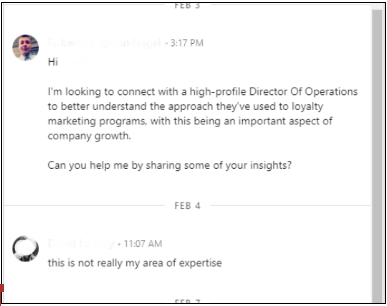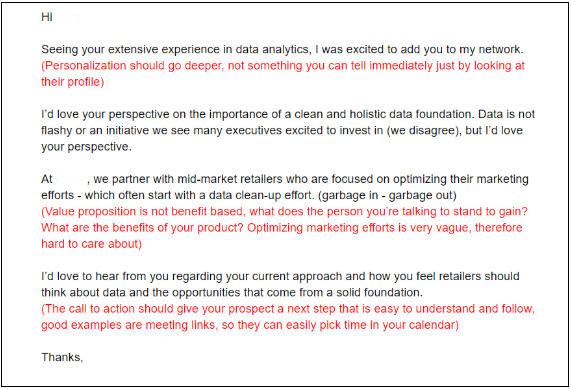Have you ever written an outbound email campaign, took a good look at your targets, wrote relevant pain points, but still got subpar results?
Don't worry, you might have done (almost) everything right, but you still would have failed, because in 2020, if you want to rise above all the noise, you have to pay attention to the following factors:
1. Mis-targeting your audiences
When messaging someone that doesn’t know you or your company, make sure your message is relevant to the recipient, and that you're reaching the correct person with a value proposition that resonates with them.
You need to have a specific go-to-market strategy and focus, otherwise, your messages might elicit this type of response:

It's OK to ask if they're dealing with the problems you're solving for, but it’s not O.K to continuously send messages that are not relevant to people who haven’t opted-in.
2. Lack of Personalization
Remember that the message should be about them. One of the main reasons people reply to B2B outbound emails is because they believe that the email was written specifically for them. Your time is well spent if you spend it personalizing your message to your most valuable prospects.
Research your prospects, learn about them and the things they care about, make them offers that they'll care about, be respectful and polite
Your number one goal is to make an impression.
You want your prospects to remember you and your company. Successful outbound campaigns sometimes won't land direct meetings all the time. They will, however, educate your target audience on problems that they might have further along in their journey, and position you as a trusted guide to help them.
An unimpressive personalization might look like this:

As you can see, the personalization is not in-depth, the message is confusing and neither the value proposition or CTA is necessarily clear.
3. Misaligned Content with Buyer's Journey
When you're reaching a prospect through outbound communication, that prospect doesn't necessarily know about you or your company. This means you must understand that they might be at a stage in their journey where they might not have encountered the problem you're solving.
It's essential to make sure that your message is created for the stage that your prospect is in, to help him along his journey.
Explain to the reader what the pain point is, show them examples of how you've solved it before.
Show how you've worked with companies that are just like them. Add in your whitepapers, case studies, or blog articles. Don't be afraid to add value and give your prospect something that will establish yourself as their trusted advisor.
Putting it all together
If you make sure that you're on point for all of the three above, your campaign will be:
- Targeting the decision-makers in your target accounts.
- Talking about pain-points that they're facing in their day-to-day lives.
- Adding value and helping them solve the problems they're annoyed with
- Educating prospects about future issues that they might encounter down the line
- Positioning yourself as a thought-leader in your industry
- Enabling them to be successful inside their organization
Remember, the only proper way to do outbound is to make sure your campaign is relevant and thoughtful.
Like this article? Find out how to create ABM messaging and SaaS messaging.
